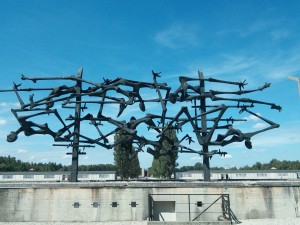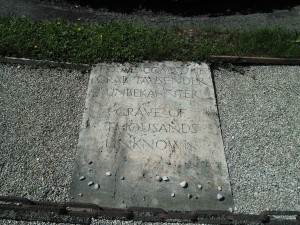I just returned from a long weekend in Munich, and I have to say it’s my favorite German city so far! I love Munich. I love everything about it. It’s just a fun, beautiful, tourist-friendly city with tons of beautiful things to see and fun things to do. I have much to tell you, but I want to devote one blog to Dachau Concentration Camp. It certainly deserves that and more.
Doc and I went the day we arrived since it was a gorgeous day, and we knew we would be walking outside most of the time. After a quick lunch, we headed to the trains. It’s outside the city and you have to take a train (25 minutes) and then a bus to the camp. Of course prisoners were not afforded the luxury of a bus to the camp, they had to walk the 3 kilometers carrying all of their belongings just to hand them over as soon as they arrived. The path that they walked is now a memorial called the Path of Remembrance along which there are panels that have been installed that document their journey.
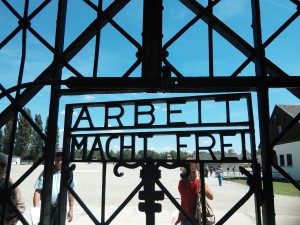 Dachau was the first concentration camp opened by the Nazi’s. It was opened in 1933 and for the first 3 months was reserved for political prisoners, not specifically Jews but people of various ethnic backgrounds. But shortly after its opening, Jews were sent here for “rehabilitation” and work. The camp was opened by Heinrich Himmler who announced in the Münchner Neuesten Nachrichten newspaper that the camp could hold up to 5,000 people and described it as “the first concentration camp for political prisoners” to be used to restore calm to Germany.
Dachau was the first concentration camp opened by the Nazi’s. It was opened in 1933 and for the first 3 months was reserved for political prisoners, not specifically Jews but people of various ethnic backgrounds. But shortly after its opening, Jews were sent here for “rehabilitation” and work. The camp was opened by Heinrich Himmler who announced in the Münchner Neuesten Nachrichten newspaper that the camp could hold up to 5,000 people and described it as “the first concentration camp for political prisoners” to be used to restore calm to Germany.
The camp’s layout and building plans were developed by Kommandant Theodor Eicke and were applied to all later camps in Germany and other countries. He had a separate secure camp near the command center that consisted of living quarters, administration, and army camps. Eicke became the chief inspector for all concentration camps, responsible for organizing others according to his model. The Dachau complex included the prisoners’ camp, which occupied approximately 5 acres, and the much larger area of SS training school including barracks, factories, plus other facilities of around 20 acres. The Kommandant was especially brutal and instilled his “no mercy” ethic in his staff. Prisoners were controlled with brutal intimidation, torture and public executions. The entrance gate where all prisoners passed through reads “Arbeit Nacht Frei” or Work Makes Freedom and served to further dehumanize prisoners.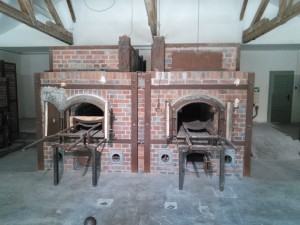
The camp was designed to hold 6,000 people at its capacity, but by 1942, there were over 12,000 prisoners there. Over the 12 years of use as a concentration camp, the Dachau administration recorded the intake of 206,206 prisoners and deaths of 31,951. Crematoria were constructed to dispose of the deceased. Visitors may now walk through the buildings and view the ovens used to cremate bodies, which hid the evidence of many deaths. It is claimed that in 1942, more than 3,166 prisoners in weakened condition were transported to other camps and were executed by poison gas because they were unfit. Poison gas chambers were built at Dachau but for some reason they were never used.
Together with the much larger Auschwitz concentration camp, Dachau has come to symbolize the Nazi concentration camps. Konzentrationslager (KZ) Dachau lives in public memory as the second camp to be liberated by British or American Allied forces. It was one of the first places that firsthand journalist accounts and newsreels revealed to the rest of the world.
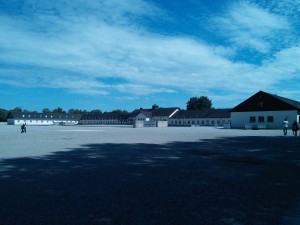 The camp is huge. The roll call area, where prisoners were sometimes forced to stand at attention for hours, is by itself huge. Only two of the barracks have been reconstructed to show visitors what the barracks were like. Photos in the museum show the barracks with
The camp is huge. The roll call area, where prisoners were sometimes forced to stand at attention for hours, is by itself huge. Only two of the barracks have been reconstructed to show visitors what the barracks were like. Photos in the museum show the barracks with 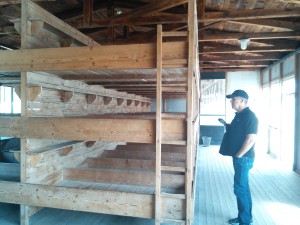 wooden beds that were designed to hold one person, stuffed with 4-6 men in a bed. The museum holds countless other photos of prisoners who lived and died there, their stories and their ghosts.
wooden beds that were designed to hold one person, stuffed with 4-6 men in a bed. The museum holds countless other photos of prisoners who lived and died there, their stories and their ghosts.
At one point during the afternoon, I felt numb. Just numb. I couldn’t feel anymore. I had seen so much that reflected the incomprehensible cruelty, brutality, inhumane and demoralizing treatment of human beings that I was just numb. My mind cannot understand how human beings can treat one another like this. I cannot wrap my head around it. And it’s going on now, again, in Iraq, where countrymen are killing their fellow countrymen because they they are “different.” Who arbitrarily decides who deserves to live, who deserves to die, who is right, who is wrong? It just makes me so incredibly sad and angry. People suffer enough in this world from natural circumstances, e.g. sickness, natural disasters, accidents, etc. This unnecessary and intentional suffering at the hands of their fellow beings is incomprehensible to me.
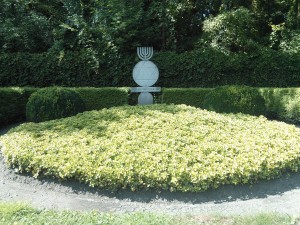 Dachau concentration camp is now a serene place with beautiful trees and flowers growing among the ashes of the dead (quite literally!). A stream runs through it and you have to wonder was it always there, taunting the prisoners who were dying of thirst and hunger. Were the roads around the camp there in 1942, and did the citizens of Dachau who drove by every day know what was going on inside the camp? Where does one’s humanity go during war and conflict? Does it take a vacation or was it ever there to begin with? I don’t know. I can only be responsible for my humanity. I hope and pray that if I am ever in the middle of a conflict that I have the courage to speak up, to voice my opposition and do the right thing even if the costs are high.
Dachau concentration camp is now a serene place with beautiful trees and flowers growing among the ashes of the dead (quite literally!). A stream runs through it and you have to wonder was it always there, taunting the prisoners who were dying of thirst and hunger. Were the roads around the camp there in 1942, and did the citizens of Dachau who drove by every day know what was going on inside the camp? Where does one’s humanity go during war and conflict? Does it take a vacation or was it ever there to begin with? I don’t know. I can only be responsible for my humanity. I hope and pray that if I am ever in the middle of a conflict that I have the courage to speak up, to voice my opposition and do the right thing even if the costs are high.
We returned to the hotel in Munich feeling spent, but also enlightened with new perspective. That’s always a good thing! I hope your day offers you a new perspective my friends along with a smile and a joyful heart!
More on Munich later!
